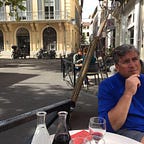Using the label to Pick the Perfect Pinot Noir
Last century, I was traveling alone in New Zealand. I was in no particular hurry. I had a years worth of wages in my pocket and all my possessions in a backpack. I was in the South Island town of Dunedin and it was a Sunday evening. I was in a quiet neighborhood cafe, sitting at the bar and I was tasting local Otago region wines with two attractive German sisters. The sisters were on holiday. One was a chef, the other a florist and they were teaching me about Pinot Noir. The three of us and the bar tender made up the entirety of the people in the cafe. He was a wine enthusiast and he kept pouring us different vintages to taste.
The first thing the sisters had to teach me was how to say Pinot Noir. This wine’s name is a tongue twister. Here is a video on how to say this grape’s name correctly.
Or read it out loud like this: (pee·no nuh·waar) and if you can, roll the (r) like the French. The second thing they tried to convince me of was the quality of the wine. Some were good but others were not and this is the problem with this grape. As Janis Robinson, one of the world’s leading wine experts writes, “The fashionable red burgundy grape is capable of producing divinely scented, gorgeously fruity expressions of place but often unwilling or unable to do so.”
So there you are, standing dumb founded in the aisle, wide eyed like a young traveler, confronted with an array of bottles and labels of a grape you can’t pronounce correctly and you are not sure you like when you try it. The wines at the top shelf are over $50 and the wines at the bottom are just under $10 and you are caught in the classic wine buyer’s trap: does price equal value and quality? The honest answer is maybe… but that doesn’t help.
Pinot Noir is made in two different distinct styles, old world (French) and new world (California). An old world style wine is high acid and lean with subtle aromatics and pairs best with food. A new world style is fuller bodied, more aromatic, sweeter, and pairs better with a book and a fire as a cocktail. The conundrum is that both old world (French) and new world (California) styles are made in all regions that produce this wine. This makes shopping for Pinot Noir based only on region an unreliable indicator of style. Here is how to confidently pick a Pinot Noir based on information on the label.
Somewhere on the label is the alcohol by volume (abv) percentage. It is required by law to be on the label but it is not required to be printed in an easy to find font or location, so you’ll have to hunt for it. Old world style wines will have an alcohol percentage of around 13%. New world styles will have an alcohol percentage of 14% or more.
So if you pick up a bottle of Pinot Noir from Sonoma and the ABV is 14.5% then you can assume it’s a new world style. The wine will smell of cherries and cola, have a deep ruby color and a pleasing velvety texture. If the same wine has and ABV of 13.5% it will smell of berries, such as raspberry, cherry and strawberry, have a crystal ruby color, feel light and crisp in the mouth and give you a nice clean palate.
While ABV helps you define the style of the wine, the quality of the wine is still unknown until opened and the price is supposed to be an indication of quality. Everyone wants to tell the story of the greatest, cheapest, wine they ever had but the only way I know of to actually, reliably, replicate these stories is by traveling in France. Honestly, in France, quality wine is 1/3 to 1/4 the price we pay here. Low quality wine, in France, is almost free. It is cheaper than gasoline and bottled water. But we can’t always travel in France and, as proven in 2020, we can’t always travel. But we can check the bottle label and make a slightly informed choice based on the alcohol by volume percentage.
The German sisters, Bridget and Gabi, had a rental car and I traveled with them for a few days. We had picnics, shared dinners together and drank more New Zealand wine. We enjoyed each others company until we parted ways in Christchurch and I headed home, back to Colorado. We never exchanged contact information and I didn’t even learn their last names. I have no way of knowing anything more about them except what was recorded in my journal in 1996, “I enjoyed Gabi’s stories on cooking and Bridget’s golden hair, long with a slight curl, her bright green eyes and her enduring smile.”
The sisters helped me appreciate, and even say the name of, Pinot Noir. This reminds me of why wine is so powerful: it is a catalyst for fixing our memories, our celebrations, and our moments in life. Wine brings people together to share experiences and that may be the most important thing we can do. Oh, and it helps when the wine tastes good too.
